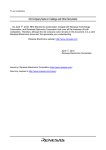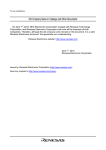Download Renesas Starter Kit for R8C/35C User`s Manual
Transcript
REJ10J2125-0100 Renesas Starter Kit for R8C/35C User’s Manual RENESAS MCU R8C Family R8C/3x Series Rev.1.00 Revision date: 01.Apr.2010 Renesas Electronics Europe Ltd. www.renesas.com i Disclaimer By using this Renesas Starter Kit (RSK), the user accepts the following terms. The RSK is not guaranteed to be error free, and the entire risk as to the results and performance of the RSK is assumed by the User. The RSK is provided by Renesas on an “as is” basis without warranty of any kind whether express or implied, including but not limited to the implied warranties of satisfactory quality, fitness for a particular purpose, title and non-infringement of intellectual property rights with regard to the RSK. Renesas expressly disclaims all such warranties. Renesas or its affiliates shall in no event be liable for any loss of profit, loss of data, loss of contract, loss of business, damage to reputation or goodwill, any economic loss, any reprogramming or recall costs (whether the foregoing losses are direct or indirect) nor shall Renesas or its affiliates be liable for any other direct or indirect special, incidental or consequential damages arising out of or in relation to the use of this RSK, even if Renesas or its affiliates have been advised of the possibility of such damages. Precautions This Renesas Starter Kit is only intended for use in a laboratory environment under ambient temperature and humidity conditions. A safe separation distance should be used between this and sensitive equipment. Its use outside the laboratory, classroom, study area or similar such area invalidates conformity with the protection requirements of the Electromagnetic Compatibility Directive and could lead to prosecution. The product generates, uses, and can radiate radio frequency energy and may cause harmful interference to radio communications. However, there is no guarantee that interference will not occur in a particular installation. If this equipment causes harmful interference to radio or television reception, which can be determined by turning the equipment off or on, you are encouraged to try to correct the interference by one or more of the following measures; z Ensure attached cables do not lie across the equipment z reorient the receiving antenna z increase the distance between the equipment and the receiver z connect the equipment into an outlet on a circuit different from that which the receiver is connected z power down the equipment when not is use z consult the dealer or an experienced radio/TV technician for help NOTE: It is recommended that wherever possible shielded interface cables are used. The product is potentially susceptible to certain EMC phenomena. To mitigate against them it is recommended that the following measures be undertaken; z The user is advised that mobile phones should not be used within 10m of the product when in use. z The user is advised to take ESD precautions when handling the equipment. The Renesas Starter Kit does not represent and ideal reference design for an end product and does not fulfil the regulatory standards for an end product. ii Table of Contents Chapter 1. Preface .................................................................................................................................................. 1 Chapter 2. Purpose ................................................................................................................................................. 2 Chapter 3. Power Supply ........................................................................................................................................ 3 3.1. Requirements ............................................................................................................................................... 3 3.2. Power – Up Behaviour ................................................................................................................................. 3 Chapter 4. Board Layout ......................................................................................................................................... 4 4.1. Component Layout ....................................................................................................................................... 4 4.2. Board Dimensions ........................................................................................................................................ 5 Chapter 5. Block Diagram ....................................................................................................................................... 6 Chapter 6. User Circuitry......................................................................................................................................... 8 6.1. Switches ....................................................................................................................................................... 8 6.2. LEDs ............................................................................................................................................................. 8 6.3. Potentiometer ............................................................................................................................................... 8 6.4. Serial port ..................................................................................................................................................... 9 6.5. Hardware LIN ............................................................................................................................................... 9 6.6. Debug LCD Module .................................................................................................................................... 10 6.7. Option Links................................................................................................................................................ 10 6.8. Oscillator Sources ...................................................................................................................................... 15 6.9. Reset Circuit ............................................................................................................................................... 15 Chapter 7. Modes.................................................................................................................................................. 16 7.1. Boot mode .................................................................................................................................................. 16 7.2. Single chip mode ........................................................................................................................................ 16 Chapter 8. Programming Methods ........................................................................................................................ 17 Chapter 9. Headers ............................................................................................................................................... 18 9.1. Microcontroller Headers ............................................................................................................................. 18 9.2. Application Headers ................................................................................................................................... 20 Chapter 10. Code Development ........................................................................................................................... 22 10.1. Overview................................................................................................................................................... 22 10.2. Compiler Restrictions ............................................................................................................................... 22 10.3. Mode Support ........................................................................................................................................... 22 10.4. Breakpoint Support ................................................................................................................................... 22 10.5. Memory Map............................................................................................................................................. 23 Chapter 11. Component Placement ...................................................................................................................... 24 Chapter 12. Additional Information........................................................................................................................ 25 iii Chapter 1. Preface Cautions This document may be, wholly or partially, subject to change without notice. All rights reserved. Duplication of this document, either in whole or part is prohibited without the written permission of Renesas Solutions Corporation. Trademarks All brand or product names used in this manual are trademarks or registered trademarks of their respective companies or organisations. Copyright © 2010 Renesas Electronics Europe Ltd. All rights reserved. © 2010 Renesas Electronics Corporation. All rights reserved. © 2010 Renesas Solutions Corporation. All rights reserved. Website: http://www.eu.renesas.com/ (Europe) http://www.renesas.com/ (Global) Glossary ADC Analog Digital Converter LIN Local Interconnect Network CPU Central Processing Unit LSI Large Scale Integration DAC Digital Analog Converter MCU Micro Controller Unit E8a E8a On-chip debugger module PC Personal Computer EMC Electromagnetic Compatibility RAM Random Access memory HEW High-Performance Embedded Workshop ROM Read Only Memory IRQ Interrupt Request RSK Renesas Starter Kit LCD Liquid Crystal Display UART Universal Asynchronous Receiver/Transmitter LED Light Emitting Diode USB Universal Serial Bus 1 Chapter 2. Purpose This Renesas Starter Kit is an evaluation tool for Renesas microcontrollers. Features include: • Renesas Microcontroller Programming. • User Code Debugging. • User Circuitry such as Switches, LEDs and potentiometer. • User or Example Application. • Sample peripheral device initialisation code. The Renesas Starter Kit board contains all the circuitry required for microcontroller operation. NOTE: This manual describes the technical details of the Renesas Starter Kit for R8C/35C hardware. The Quick Start Guide and Tutorial Manual provide details of the software installation and debugging environment. 2 Chapter 3. Power Supply 3.1. Requirements This Renesas Starter Kit operates from a 5V power supply. A diode provides reverse polarity protection only if a current limiting power supply is used. This Renesas Starter Kit board is supplied with an E8a debugger. This product is able to power the Renesas Starter Kit board with up to 300mA. When the Renesas Starter Kit is connected to another system then that system should supply power to the Renesas Starter Kit. All Renesas Starter Kit boards have an optional centre positive supply connector using a 2.1mm barrel power jack. Warning The Renesas Starter Kit is neither under nor over voltage protected. Use a centre positive supply for this board. 3.2. Power – Up Behaviour When the Renesas Starter Kit is purchased the Renesas Starter Kit board has the ‘Release’ or stand alone code from the example tutorial code pre-programmed into the Renesas microcontroller. On powering up the board the user LEDs will start to flash. After 200 flashes, or after pressing a switch the LEDs will flash at a rate controlled by the potentiometer. 3 Chapter 4. Board Layout 4.1. Component Layout The following diagram shows the top layer component layout of the board. Application Board Interface Reset Switch JA1 RS232 Serial Debug LCD DC Power DC Power (Option) J4 Power LED E8a Header Power Connector for LIN J1 MCU J3 User LEDs LIN Connector J2 Boot LED User/Boot Switch JA2 Potentiometer Application Board Interface J1 to J4: Microcontroller Pin Headers Figure 4-1: Board Layout 4 User Switch 4.2. Board Dimensions The following diagram gives the board dimensions and connector positions. All through hole connectors are on a common 0.1” grid for easy interfacing. 3.81 5.00 45.00 14.00 JA1 39.37 52.07 67.31 77.47 85.00 92.71 100.00 J4 J1 MCU J3 J2 JA2 27.00 27.94 38.10 50.80 53.34 73.66 80.00 85.00 Figure 4-2 : Board Dimensions 5 Chapter 5. Block Diagram Figure 5-1 is representative of the CPU board components and their connectivity. Power Jack Boot mode pin Microcontroller Pin Headers RESET pin BOOT Circuitry D-type Latch Microcontroller E8a LIN Connector, Power Connector for LIN IRQ pins ADC Input I/O Serial Connector SW3 SW2 SW1 BOOT RES Switches Potentiometer LCD Display Data x4 Control x2 User LED x4 1Green, 1Orange, 2Red LEDs Figure 5-1: Block Diagram 6 POWER: Green BOOT: Orange BOOT & BOOTn signals Application Board Interface Figure 5-2 is representative of the connections required to the Renesas Starter Kit. USB Cable Personal Computer E8a emulator User Interface Cable Pin 1 E8a MCU CPU Board Figure 5-2 : Renesas Starter Kit Connections 7 Chapter 6. User Circuitry 6.1. Switches There are four switches located on the board. The function of each switch and its connection are shown in Table 6-1. Switch Function Microcontroller RES When pressed, the board microcontroller is reset. RESETn, Pin8 SW1/BOOT* Connects to an IRQ input for user controls. INT1n, Pin31 The switch is also used in conjunction with the RES switch to place (Port 1, pin 7) the device in BOOT mode when not using the E8a debugger. SW2* Connects to an IRQ Interrupt input for user controls. INT2n, Pin28 (Port 6, pin 6) SW3* Connects to an IRQ Interrupt input for user controls. ADTRGn_INT0n, Pin30 Connects to an ADTRG input for AD trigger controls. (Port 4, pin 5) Table 6-1: Switch Functions *Refer to schematic for detailed connectivity information. 6.2. LEDs There are six LEDs on the CPU board. The green ‘POWER’ LED lights when the board is powered. The orange ‘BOOT’ LED indicates the device is in BOOT mode when lit. The four user LEDs are connected to an IO port and will light when their corresponding port pin is set low. Table 6-2, below, shows the LED pin references and their corresponding microcontroller port pin connections. LED Reference Colour (As shown on silkscreen) Microcontroller Port Microcontroller Pin Number Pin function LED0 Green Port 3.1 26 LED1 Orange Port 3.3 16 LED2 Red Port 3.4 15 LED3 Red Port 3.6 25 Table 6-2: LED Port 6.3. Potentiometer A single turn potentiometer is connected to AN8 (Port1.0) of the microcontroller. This may be used to vary the input analog voltage value to this pin between VREF and Ground. The potentiometer is fitted to offer an easy way of supplying a variable analog input to the controller. It does not necessarily reflect the accuracy of the controllers ADC. Please see the device manual for details. 8 6.4. Serial port Serial port UART0 and serial port UART1 are connected to the RS232 transceiver. These serial ports can optionally be connected to the RS232 transceiver as well by fitting option resistors. The connections are listed in the Table 6-3. Description Circuit Net Function Fit for RS232 Remove for RS232 Name UART0 *1 LINTXD Secondary Serial Port R48 R46, R47, R65, R66 UART0 *1 LINRXD Secondary Serial Port R49 UART1 *2, *3 TXD1 Default Serial Port R46, R70 UART1 *2, *3 RXD1 Default Serial Port R47, R72 R48, R49, R71, R73 Table 6-3: Serial Port settings *1: The UART0 port is shared with the LIN module. *2: The UART1 port is shared with the I/O pin on JA1 application header. *3: The UART1 port is also available on JA2 application header. 6.5. Hardware LIN Hardware LIN could be connected to TXD0, RXD0 and CLK0 pins. The connections to be fitted are listed in the Table 6-4. Description Function Circuit Net Device Fit for Remove for Name Pin Hardware LIN Hardware LIN LIN TXD LINTXD 34 R66 R48 LIN RXD LINRXD 33 R65 R49 LIN NSLP LINNSLP 32 R64 - Table 6-4: Hardware LIN settings Hardware LIN can be selected as Master or Slave. Resistor selections are listed in the Table 6-5. Master and Slave Selection Resistor Master Slave R67 Fit Remove R68 Fit Remove Table 6-5: LIN Master and Slave Selection 9 6.6. Debug LCD Module A LCD module is supplied to be connected to the connector LCD. This should be fitted so that the LCD module lies over J4. Care should be taken to ensure the pins are inserted correctly into LCD. The LCD module uses a 4 bit interface to reduce the pin allocation. No contrast control is provided; this is set by a resistor on the supplied display module. The module supplied with the Renesas Starter Kit only supports 5V operation. Table 6-6 shows the pin allocation and signal names used on this connector. LCD Pin Circuit Net Name Device Pin Circuit Net Name Device Pin Pin 1 Ground - 2 Board_VCC (5V Only) - 3 No Connection - 4 DLCDRS (Port 6.5) 29 5 R/W (Wired to Write only) - 6 DLCDE (Port 6.4) 47 7 No Connection - 8 No Connection - 9 No Connection - 10 No Connection - 11 DLCDD4 (Port 6.0) 51 12 DLCDD5 (Port 6.1) 50 13 DLCDD6 (Port 6.2) 49 14 DLCDD7 (Port 6.3) 48 Table 6-6: Debug LCD Module Connections 6.7. Option Links Table 6-7 below describes the function of the option links associated with Power configuration. The default configuration is indicated by BOLD & Red text. Option Link Settings Reference R21 R23 R24 R25 Function Power Supply Power Supply Power Supply MCU Power Supply Fitted Alternative (Removed) Enables external 5V power Disables power supply from supply from PWR1 connector PWR1 connector. Must be fitted if supplying Disconnects power supply from voltage from CON_5V CON_5V Must be fitted if supplying Disconnects power supply voltage from CON_3V3 from CON_3V3 Supply to MCU Disables power supply for MCU. Current can measured across J6. Table 6-7: Power Configuration Links 10 Related To - Table 6-8 below describes the function of the option links associated with Clock configuration. The default configuration is indicated by BOLD & Red text. Option Link Settings Reference R1 R2 Function Fitted Alternative (Removed) 20MHz Main Clock Parallel resistor for on-board Oscillator main clock X1. 20MHz Main Clock X1 is used for XIN Oscillator R3 20MHz Main Clock R5 Not fitted - External clock source is used R3, R4, R5 for XIN X1 is used for XOUT External clock source is used Oscillator R4 Related To R2, R4, R5 for XOUT 20MHz Main Clock Routes XIN CPU pin to J1 XIN CPU pin and J1 header Oscillator header are not connected 20MHz Main Clock Routes XOUT CPU pin to J1 XOUT CPU pin and J1 and Oscillator and JA2 headers JA2 headers are not (External clock source is used connected R2, R3, R5 R2, R3, R4 for XOUT) R6 R7 Not fitted - X2 is used for XCIN X2 is disconnected for XCIN R8, R9, R10 X2 is used for XCOUT X2 is disconnected for XCOUT R7, R9, R10 32.768kHz Sub Clock Routes XCIN CPU pin to J1 XCIN CPU pin and J1 header R7, R8, R10 Oscillator header are not connected 32.768kHz Sub Clock Routes XCOUT CPU pin to J1 XCOUT CPU pin and J1 Oscillator header header are not connected 32.768kHz Sub Clock Parallel resistor for on-board Oscillator sub clock X2. 32.768kHz Sub Clock Oscillator R8 32.768kHz Sub Clock Oscillator R9 R10 Table 6-8: Clock Configuration Links 11 R7, R8, R9 Table 6-9 below describes the function of the option links associated with Analog configuration. The default configuration is indicated by BOLD & Red text. Option Link Settings Reference R11 Function Fitted Alternative (Removed) Reference Voltage Reference voltage source is Reference voltage source is Source taken from the external set to UC_VCC Related To R12, R13 connector CON_VREF to ADPOT R12 Reference Voltage Reference voltage source is Reference voltage source is Source set to UC_VCC taken from the external R11, R13 connector CON_VREF to ADPOT R13 Reference Voltage Supply to MCU Disconnected R11, R12 Connects on-board Disconnected - Source R14 ADPOT potentiometer ADPOT to MCU Port1.0 (MCU Pin#38) Table 6-9: Analog Configuration Links 12 Table 6-10 below describes the function of the option links associated with application board interface configuration. The default configuration is indicated by BOLD & Red text. Option Link Settings Reference R56 R57 R58 R59 R60 R61 R70 R71 R72 R73 R74 R75 Function Fitted Alternative (Removed) Application Board Connects DA0 to MCU Interface Port0.6 (MCU Pin#40) Application Board Connects IO6 to MCU Port0.6 Interface (MCU Pin#40) Application Board Connects DA1 to MCU Interface Port0.7 (MCU Pin#39) Application Board Connects IO7 to MCU Port0.7 Interface (MCU Pin#39) Application Board Connects ADTRGn to MCU Interface Port4.5(MCU Pin#30) Application Board Connects INT0n to MCU Interface Port4.5(MCU Pin#30) Application Board Connects TXD1 to MCU Interface Port0.1 (MCU Pin#45) Application Board Connects IO1 to MCU Port0.1 Interface (MCU Pin#45) Application Board Connects RXD1 to MCU Interface Port0.2 (MCU Pin#44) Application Board Connects IO2 to MCU Port0.2 Interface (MCU Pin#44) Application Board Connects CLK1 to MCU Interface Port0.3 (MCU Pin#43) Application Board Connects IO3 to MCU Port0.3 Interface (MCU Pin#43) Disconnected R57 Disconnected R56 Disconnected R59 Disconnected R58 Disconnected R61 Disconnected R60 Disconnected R71 Disconnected R70 Disconnected R73 Disconnected R72 Disconnected R75 Disconnected R74 Table 6-10: Application Board Interface Links 13 Related To Table 6-11 below describes the function of the option links associated with other options. The default configuration is indicated by BOLD & Red text. Option Link Settings Reference R30 Function SW1 Fitted Alternative (Removed) Connects SW1 to MCU Related To Disconnected - Disconnected - Disconnected - Do not remove resistor R50 - Port1.7 (MCU Pin#31) R31 SW2 Connects SW2 to MCU Port6.6 (MCU Pin#28) R32 SW3 Connects SW3 to MCU Port4.5 (MCU Pin#30) R50 E8a Enables E8a Connection Table 6-11: Other Option Links 14 6.8.Oscillator Sources Crystal oscillators are fitted on the board and used to supply the main/sub clock input to the Renesas microcontroller. Table 6-12 details the oscillators that are fitted and alternative footprints provided on this board: Component Main clock (X1) Fitted 20 MHz (HC/49U package) Sub clock (X2) Fitted 32.768 kHz (90SMX package) Table 6-12: Oscillator 6.9.Reset Circuit The CPU Board includes a simple latch circuit that links the mode selection and reset circuit. This provides an easy method for swapping the device between Boot mode and Single chip mode. This circuit is not required on customers’ boards as it is intended for providing easy evaluation of the operating modes of the device on the Renesas Starter Kit. Please refer to the hardware manual for more information on the requirements of the reset circuit. The Reset circuit operates by latching the state of the boot switch on pressing the reset button. This control is subsequently used to modify the MODE pin states as required. The MODE pin should change state only while the reset signal is active to avoid possible device damage. The reset is held in the active state for a fixed period by a pair of resistors and a capacitor. Please check the reset requirements carefully to ensure the reset circuit on the customers’ board meets all the reset timing requirements. 15 Chapter 7. Modes The Renesas Starter Kit supports Boot mode and Single chip mode. Details of programming the FLASH memory is described in the R8C/35C Group Hardware Manual. 7.1. Boot mode The Boot mode settings for this Renesas Starter Kit are shown in Table 7-1 below: MODE LSI State after Reset End Low Boot Mode Table 7-1: Boot Mode pin settings The software supplied with this Renesas Starter Kit supports Boot mode using an E8a and High-performance Embedded Workshop only. However, hardware exists to enter boot mode manually, do not connect the E8a in this case. Press and hold the SW1/BOOT. The MODE pin is held in its boot state while reset is pressed and released. Release the boot button. The BOOT LED will be illuminated to indicate that the microcontroller is in Boot mode. When neither the E8a is connected nor the board is placed in Boot mode as above, the MODE pin is pulled high by a 4.7k resistor. When an E8a is used the MODE pin is controlled by the E8a. 7.2. Single chip mode Because the MODE pin is pulled high, this Renesas Starter Kit will always boot in Single chip mode when the E8a is not connected and the boot switch is not depressed. Refer to R8C/35C Group Hardware Manual for details of Single chip mode. MODE LSI State after Reset End High Single chip Mode Table 7-2: Single chip Mode pin settings 16 Chapter 8. Programming Methods The board is intended for use with High-performance Embedded Workshop and the supplied E8a debugger. Refer to R8C/35C Group Hardware Manual for details of programming the microcontroller without using these tools. 17 Chapter 9. Headers 9.1. Microcontroller Headers Table 9-1 to Table 9-4 show the microcontroller pin headers and their corresponding microcontroller connections. The header pins connect directly to the microcontroller pin unless otherwise stated. J1 Pin Circuit Net Name Device Pin Pin Circuit Net Name Device Pin 1 UD 1 2 TRIGb 2 3 TMR1 3 4 VREF 4 5 MODE 5 6 CON_XCIN 6 7 CON_XCOUT 7 8 RESETn 8 9 CON_XOUT 9 10 Ground 10 11 CON_XIN 11 12 UC_VCC 12 13 PIN13 13 14 (Not used) - Table 9-1: J1 J2 Pin Circuit Net Name Device Pin Pin Circuit Net Name Device Pin 1 PIN14 14 2 LED2 15 3 LED1 16 4 Wn 17 5 Vn 18 6 Wp 19 7 Vp 20 8 Un 21 9 Up 22 10 TMR0 23 11 TRIGa 24 12 LED3 25 13 LED0 26 14 (Not used) - Table 9-2: J2 18 J3 Pin Circuit Net Name Device Pin Pin Circuit Net Name Device Pin 1 INT3n 27 2 INT2n 28 3 DLCDRS 29 4 ADTRGn_INT0n 30 5 INT1n 31 6 LINNSLP 32 7 LINRXD 33 8 LINTXD 34 9 AN11 35 10 AN10 36 11 AN9 37 12 AN8 38 13 DA1_IO7 39 14 (Not used) - Table 9-3: J3 J4 Pin Circuit Net Name Device Pin Pin Circuit Net Name Device Pin 1 DA0_IO6 40 2 IO5 41 3 IO4 42 4 IO3_CLK1 43 5 IO2_RXD1 44 6 IO1_TXD1 45 7 IO0 46 8 DLCDE 47 9 DLCDD7 48 10 DLCDD6 49 11 DLCDD5 50 12 DLCDD4 51 13 TRISTn 52 14 (Not used) - Table 9-4: J4 19 9.2. Application Headers Table 9-5 and Table 9-6 below show the standard application header connections. * Marked pins are subject to option links. JA1 Pin Header Name Circuit Net Device Name Pin Pin Header Name Circuit Net Device Name Pin 1 Regulated Supply 1 CON_5V - 2 Regulated Supply 1 Ground - 3 Regulated Supply 2 CON_3V3 - 4 Regulated Supply 2 Ground - 5 Analog Supply NC - 6 Analog Supply NC - 7 Analog Reference CON_VREF 4 8 ADTRG ADTRGn* 30 9 AD0 AN8 38 10 AD1 AN9 37 11 AD2 AN10 36 12 AD3 AN11 35 13 DAC0 DA0* 40 14 DAC1 DA1* 39 15 IOPort0 IO0 46 16 IOPort1 IO1* 45 17 IOPort2 IO2* 44 18 IOPort3 IO3* 43 19 IOPort4 IO4 42 20 IOPort5 IO5 41 21 IOPort6 IO6* 40 22 IOPort7 IO7* 39 23 IRQ3 INT3n 27 24 IIC_EX NC - 25 IIC_SDA SDA 13 26 IIC_SCL SCL 14 Table 9-5: JA1 Standard Generic Header JA2 Pin Header Name Circuit Net Device Name Pin Pin Header Name Circuit Net Device Name Pin 1 Reset RESETn 8 2 External Clock Input CON_XOUT 9 3 Interrupt NC - 4 Regulated Supply 1 Ground - 5 WDT overflow NC - 6 Serial Port TXD1* 45 7 IRQ0 INT0n* 30 8 Serial Port RXD1* 44 9 IRQ1 INT1n 31 10 Serial Port CLK1* 43 11 Motor up/down UD 1 12 Serial Port Handshake NC - 13 Motor control Up 22 14 Motor control Un 21 15 Motor control Vp 20 16 Motor control Vn 18 17 Motor control Wp 19 18 Motor control Wn 17 19 Timer Output TMR0 23 20 Timer Output TMR1 3 21 Timer Input TRIGa 24 22 Timer Input TRIGb 2 23 IRQ2 INT2n 28 24 Tristate Control TRISTn 52 25 SPARE NC - 26 SPARE NC - Table 9-6: JA2 Standard Generic Header 20 Table 9-7 below show the LIN header connections. J9 Pin Function Signal Name 1 Power Supply (for LIN module) VBAT 2 Ground Ground LIN Pin Function Signal Name 1 Power Supply (for LIN module) VBAT 2 LIN Bus Line LIN 3 Ground Ground Table 9-7: LIN Headers 21 Chapter 10.Code Development 10.1. Overview Note: For all code debugging using Renesas software tools, the Renesas Starter Kit board must be connected to a Personal Computer USB port via an E8a. An E8a is supplied with the Renesas Starter Kit product. 10.2. Compiler Restrictions The compiler supplied with this Renesas Starter Kit is fully functional for a period of 60 days from first use. After the first 60 days of use have expired, the compiler will default to a maximum of 64k code and data. To use the compiler with programs greater than this size you need to purchase the full tools from your distributor. Warning: The protection software for the compiler will detect changes to the system clock. Changes to the system clock back in time may cause the trial period to expire prematurely. 10.3. Mode Support High-performance Embedded Workspace connects to the Microcontroller and programs it via the E8a. Mode support is handled transparently to the user. 10.4. Breakpoint Support High-performance Embedded Workshop supports breakpoints on the user code, both in RAM and ROM. Double clicking in the breakpoint column in the code sets the breakpoint. Breakpoints will remain unless they are double clicked to remove them. 22 10.5. Memory Map 02BFFh 04000h 23FFFh Figure 10-1 : Memory Map for R5F2135CCDFP (ROM: 128K+4K, RAM: 10K) 23 Chapter 11. Component Placement JA1 SERIAL RES R26 R23 R24 R18 R19 R20 R58 R59 R56 R57 R17 GND1 C21 U3 R48 R46 R45 R47 R49 R44 R43 C18 C17 C9 POWER LED0 LED1 LED2 R36 LED3 R38 BOOT R50 C13 R41 R40 C15 R28 R31 SW2 R39 C14 U2 TR2 GND3 24 D3 Figure 11-1 : Component Placement R53 R35 R14 C8 C6 C7 R12 R11 R13 SW3 E8A TR1 C16 J7 C23 R67 RV1 R29 R32 R42 J8 R2 J2 GND2 JA2 R34 C1 R1 C2 R63 R65 R64 R66 R62 R4 U4 R33 R16 X1 LIN R61 U1 C3 J10 J3 R60 R3 R5 J1 R37 R8 GND4 R6 R15 R10 PWR2 R22 C5 X2 J5 R7 J6 R25 D4 C22 R54 C25 C4 D2 C12 R69 R55 J4 R9 C11 D1 C24 C26 R68 C27 R21 R75 R74 R72 R73 R70 R71 T7 PWR1 C20 C10 LCD J9 C19 R51 R52 R27 R30 SW1/BOOT Chapter 12. Additional Information For details on how to use High-performance Embedded Workshop, refer to the High-performance Embedded Workshop manual available on the CD or from the web site. For information about the R8C/35C group microcontrollers, refer to the R8C/35C Group Hardware Manual. For information about the R8C/35C assembly language, refer to the R8C Family Software Programming Manual. For information about the E8a Emulator, please refer to the E8A-USB Emulator User’s Manual. Online technical support and information is available at: http://www.renesas.com/renesas_starter_kits Technical Contact Details America: [email protected] Europe: [email protected] Japan: [email protected] General information on Renesas Microcontrollers can be found on the Renesas website at: http://www.renesas.com/. 25 Renesas Starter Kit for R8C/35C User's Manual Publication Date Rev.1.00 01.Apr.2010 Published by: Renesas Electronics Europe Ltd. Duke’s Meadow, Millboard Road, Bourne End Buckinghamshire SL8 5FH, United Kingdom ©2010 Renesas Electronics Europe and Renesas Solutions Corp., All Rights Reserved. Renesas Starter Kit for R8C/35C User's Manual Renesas Electronics Europe Ltd. Dukes Meadow, Millboard Road, Bourne End, Buckinghamshire, SL8 5FH, United Kingdom






























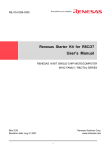
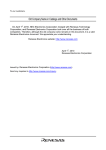
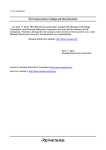
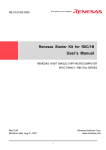




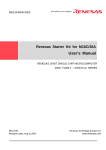
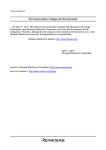
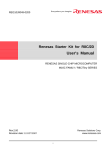

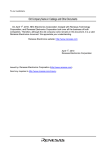
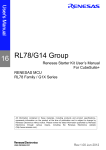

![[e 2 studio] Renesas Starter Kit for RL78/G14 User`s Manual](http://vs1.manualzilla.com/store/data/005759786_1-25eb95ad780cf22f415f84b4d3ed0c87-150x150.png)


